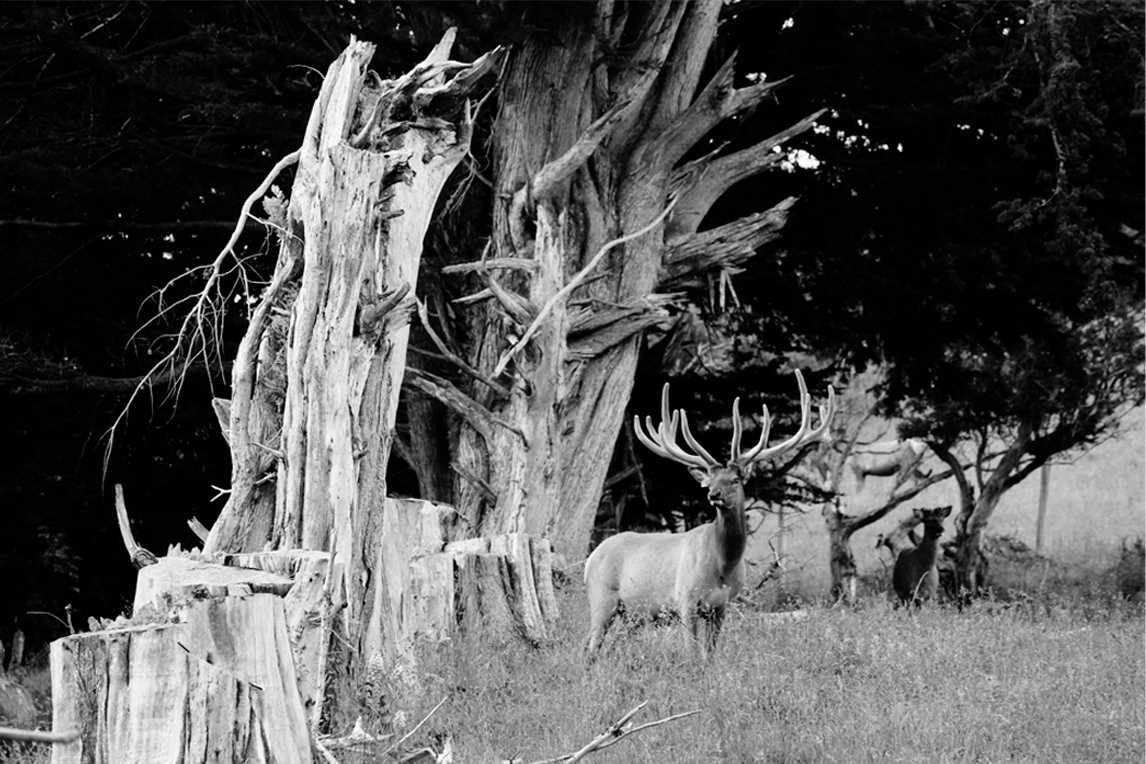May 31, 2021

The NZ farmed deer industry is renowned for its innovation and the quality and diversity of its products. Deer Industry New Zealand (DINZ) works with others to enhance this reputation and to promote the interests of all industry participants.
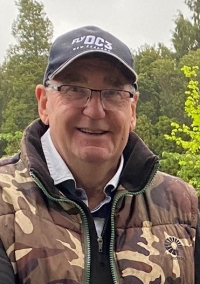 The winner of the 2021 New Zealand Deer Industry Award is one of the industry’s most respected and longest-serving stalwarts, John (‘JT’) Tacon.
The winner of the 2021 New Zealand Deer Industry Award is one of the industry’s most respected and longest-serving stalwarts, John (‘JT’) Tacon.
His award was a popular choice among those attending the 2021 conference awards dinner in Invercargill. Current and former industry leaders endorsed his nomination, saying his huge contribution justified an exception to the unwritten rule that DINZ staff do not receive the prestigious Deer Industry Award.
“JT carries the mana of a lifetime of experience, theory and practical knowledge on animal welfare and transport. Our ability to allow trained and skilled farmers to undertake a surgical procedure [velvetting] is in no small part due to his early and on-going work,” said DINZ chief executive Innes Moffat.
High standards of deer welfare in transport and the widespread adoption of on-farm quality assurance are based on the pioneering work led by JT. He also led the implementation of the Regulatory Control Scheme for velvet removal. The success of these initiatives, which require people to change the way they operate, is credited to his consultative and practical approach.
A profile of JT will appear in the June/July edition of Deer Industry News.
Kaipara deer farmers Diane and Ian Bristow are the winners of the 2021 Matuschka award. This award acknowledges the contribution of a grass roots deer farmer who has made a significant ongoing or lifetime of contribution to deer farming and the NZDFA in particular at Branch level… the unsung contributor to local area activities, functions and core spirit of deer farming.
The contribution of the Bristows to deer farming will be covered in the June issue of Stagline OnLine and the June/July edition of Deer Industry News.
Maybe it was the snow flurries outside. Maybe it was the phenomenal line-up of vehicles in Bill Richardson Transport World – the conference venue. Or maybe the stars were simply in alignment, but the 2021 Deer Industry Conference in Invercargill a fortnight ago was a humdinger.

A good range of speakers. Candour from all sections of the industry about things they could have done better. Praise freely given for things that went well. Great questions from delegates, honest answers from speakers. Plenty of laughs. No political grand-standing. And as you would expect, much more to eat and drink than anyone really needed.
About 170 attended the two days of conference and a similar number the National Technical Workshop the following day. Big thanks go to everyone who made it possible, but most particularly to the conference organiser-in-chief Tony Pearse, Some random highlights from the conference are included in this edition of DINZ eNews, with detailed coverage to follow in June/July Deer Industry News.
Full coverage of the conference can be found on YouTube. Search for ‘Deer Conference 2021’.
DINZ producer manager Tony Pearse reports that several deer farms have suffered major damage to fences, tracks and other infrastructure during the weather bomb that struck two days ago. The storm has now eased in South Canterbury and is moving north, posing a threat to farmers in North Canterbury.
“PGG Wrightson deer agent Murray Coutts has been in touch with most of the large properties that are badly affected. He has also talked with DINZ board member Kris Orange, South Canterbury NZDFA chair Graeme Peck and DINZ QA manager John Tacon,” Pearse says.
“A number of larger operations have been affected in and around the Mt Peel, Peel Forest, Lincoln Hills, the Opihi catchment and Raincliff area and out onto the plains. It’s a very tight-knit community with large farms and staff and they are working together and assisting each other where possible.”
Boundary fences in some places have been destroyed and there’s been much internal damage and flooding. A herd that escaped has now been recovered and other herds have been relocated. There has been significant crop damage and loss of wrapped baleage in flood waters and in Murray Coutts’ view, finding replacement baleage in quantity is likely to be the biggest challenge once boundary and other fences have been secured. DINZ staff and NZDFA branch officials are continuing to monitor the situation and are ready to work with affected farmers if deer need to be relocated and emergency feed supplies secured.
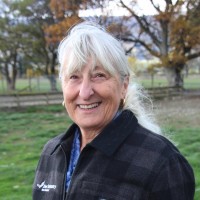 Registrations for VelTrak are continuing to roll in, with more than half of all accredited farms now signed up, says Deer QA administrator Pam McLeman, who also manages the helpdesk.
Registrations for VelTrak are continuing to roll in, with more than half of all accredited farms now signed up, says Deer QA administrator Pam McLeman, who also manages the helpdesk.
“Registration will be required for every farm that wants to sell velvet from the 2021/22 season, which is now only six months away. So, if you haven’t registered, do so now – or give the helpdesk a call. We have yet to hear a problem or concern that can’t be resolved. We’re here to help.”
Speaking during the VelTrak presentation at the Deer Industry Conference in Invercargill, DINZ board member Mark Harris said rapid, accurate, traceability was required under the Regulated Control Scheme, as well as by our customers.
He compared the traceability required for velvet with that required by Gallagher from their suppliers: “An electric fence controller has 200-300 component parts. The quality of those components is fundamental to the success of Gallagher in the marketplace.”
Gallagher only buys its parts from trusted brands, so it can deliver on its promise to its customers. But in the unlikely event that something goes wrong – and it only happens very rarely – Gallagher needs to know that each of those parts is fully traceable.
“That’s the same as the health food companies that buy our velvet to make their products and to make claims to their customers. They, like Gallagher, require traceability from all their suppliers so that if a stuff-up happens they resolve the issue for their customers as quickly as possible and get back to business.”
Going by a show of hands, half the farmers at the 2021 conference know their greenhouse gas (GHG) emissions number. The deadline for all farmers and growers to know their numbers is the end of 2022.
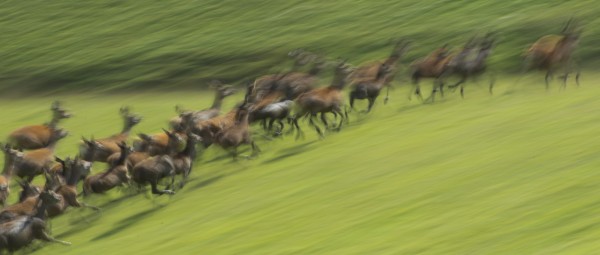
GHG numbers may be blurry, but they still matter
This is laid down in the Zero Carbon Act and is strongly supported by farming leaders and iwi under the banner of He Waka Eke Noa. This initiative aims to put responsibility for farm emission reductions (including offsets) under the control of individual farmers. The alternative is a carbon levy imposed by government on processors that would in effect be a flat tax paid by all suppliers, regardless how carbon-efficient they are.
Knowing your number doesn’t of itself mean much, without knowing what offsets are available or the pricing policy that will apply to the various gases. But it matters, says DINZ environmental stewardship manager Lindsay Fung, “Because regulators need to know farmers are engaged. That we are taking GHG reductions seriously. You also might like to know whether you may be facing a $5000 problem or a $50,000 problem.”
To calculate your GHG number, there are four tools available for use on deer farms: Beef+Lamb NZ’s GHG calculator, Farmax, Overseer-FM and an MfE spreadsheet. DINZ farm performance manager Phil McKenzie says DINZ, working through Advance Parties and Deer Industry Environmental Groups, will help deer farmers calculate their GHG numbers.
Using National Inventory data, Fung calculates that deer lie somewhere between sheep and beef cattle in terms of their GHG emissions – around 69 tonnes of C02 equivalent per year per 100 animals.
Three of the four tools suitable for calculating emissions were recently assessed on 10 farming properties. On the one deer farm in the study there was a huge variation in GHG output figures, depending on the calculator used. GHG output ranged from 3960 kg/ha (the MfE spreadsheet) to 6300 kg/ha (Overseer-FM).
To get a better handle on the four tools, DINZ will revisit four deer farms that had their GHG outputs assessed by AgFirst in 2019, along with potential offsets and reductions.
 DINZ has engaged Megan McCall as a part time environment project manager for the P2P Deer Industry Environment Groups (DIEGs). Her immediate objective is to encourage deer farmers who don’t know their greenhouse gas (GHG) numbers, or who don’t have a written wintering plan for their intensively grazed deer, to join a Deer Industry Environment Group.
DINZ has engaged Megan McCall as a part time environment project manager for the P2P Deer Industry Environment Groups (DIEGs). Her immediate objective is to encourage deer farmers who don’t know their greenhouse gas (GHG) numbers, or who don’t have a written wintering plan for their intensively grazed deer, to join a Deer Industry Environment Group.
The DIEGs, which operate in a similar way to Advance Parties, have been strongly supported by deer farmers, with 15 groups involving 125 farmers now operating. Phil McKenzie says farmer members of the groups support each other when putting their farm environment and certified freshwater plans together. DINZ will also help members calculate their GHG numbers.
The drivers are the government’s proposed intensive winter grazing (IWG) regulations and its proposal to introduce agriculture into the emissions trading scheme in 2025. In both cases, farmers are on notice to demonstrate that they are taking these issues seriously. If they get winter grazing right, the regulations are expected to be less onerous and involve less bureaucracy than would otherwise be the case.
McCall, who also works at AbacusBio, helps clients achieves their farm business goals and is an experienced facilitator. She can be contacted at AbacusBio, Tel 03 477 6375; 027 207 6074; or mmccall@abacusbio.co.nz
The industry’s genetic database, Deer Select, is winning a growing number of clients among commercial velvet producers.
Manager Sharon McIntyre says the genetic parameters for velvet weight have been recalculated based on the dataset within Deer Select. This shows velvet is not as heritable as many think – it’s about 45-50% heritable rather than the often mentioned 75-80%. Using all records on all relatives to make predictions adds more value to selection decisions. This makes it a valuable tool for farmers wanting to calculate within-herd breeding values.
Although Deer Select has only limited across-herd herd data for velvet weights – its greatest strength lies in its cross-herd maternal, venison and CARLA BVs – this isn’t putting velvet farmers off. They are finding it to be much more accurate and easier to use than an Excel spreadsheet at home.
“Deer Select BVs can help with female selection as these are usually selected at 12 months of age before half-brothers have 2 year old records. Also some hinds don’t have male progeny for some years,” McIntyre says.
In the longer term McIntyre would like to see breeding values developed for traits that measure velvet quality. Like bio-active content and perhaps circumference measures on different sections of the velvet, to discourage overly large tops. These would require an investment in research, but at a certain point – likely not too far down the track – the focus of antler selection will likely shift to bioactive content and processing quality.
More? Ring 027 634 9387, sharon.mcintyre@deernz.org
Starting in October this year, Deer Select will move to a much improved web platform, ‘nProve’, operated by Sheep Improvement Limited – the sheep breeding database on which Deer Select sits.
Deer Select manager Sharon McIntyre calls the new interface Deer Select Mark II. Not only will it integrate well with other farm management software, it will – for the first time – enable farmers to directly compare deer in genetically connected reds and elk/wapiti herds. Cross-breed comparisons have been several years in the making, but will be welcomed by many buyers of terminal sires.
Also to change will be in the base year for calculating BVs, from 1995 to 2005. This will result in a downward adjustment in the BV indexes, but not by a huge amount – genetic gain has really only taken off in the last 15 or so years.
Deer Select is slated for a further upgrade to Mark III, possibly as early as 2023/24, when genomic information will be introduced into the calculation of breeding values. Genomics is the science that links genetic information from DNA with performance data to give more accurate predictions of merit as it can track the inheritance contributions more accurately.
Developing the genomic data is a combined AgResearch and DINZ science activity.
There has been a dramatic improvement in farmer compliance with the requirement to tag deer and notify NAIT before moving them from a farm – either to another farm or to the processor. Two years ago, OSPRI – the organisation that operates NAIT – was reporting that whole lines of untagged deer were turning up at deer slaughter plants.
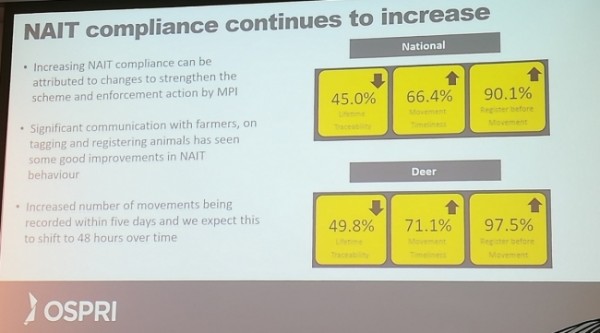
At the NZDFA annual meeting in Invercargill, a NAIT representative said 97.5% of deer are now registered with NAIT before being trucked, versus 90.1% for all stock (cattle and deer). Compliance with the requirement to notify NAIT of the movement within 48 hours of the animals going on the truck is not quite so good: 77.1% (66.4% all stock).
More good news on the NAIT front is a concerted effort by OSPRI to modernise the ‘My OSPRI’ software so it is easier to use, more mobile-friendly and works with other farm management software in “intelligent ways”. Some of the improvements are already in place, with another instalment expected in July.
Not so positive – and something of a head-scratcher -- is the news that only 49.8% of deer have lifetime traceability. DINZ and OSPRI are trying to get the bottom of this, as it doesn’t seem to be consistent with the other very positive stats.
Surfing for Farmers (SFF) is a mental health initiative that uses surfing as a vehicle to get farmers off their farms and into the ocean for a free-learn to-surf lesson. It’s located in 18 regions around NZ with 300-350 farmers surfing each week during summer, a total 2814 farmer surfs across the country.

SFF is running a raffle raise funds for their activities next summer. Tickets cost $50 each, with a wonderful prize on offer: Flights for two to Gisborne and return for a weekend, accommodation, instruction from a surfing pro, a wetsuit and a surfboard. Plus 50 SFF hoodies as consolation prizes.
Direct credit the $50 ticket price to the SFF bank account 03-0638-0057065-00 and put your name and phone number in the reference fields. Contact Jack Dustin, Surfing for Farmers, Tel 027 899 8007, www.surfingforfarmers.com. Only 1500 tickets to be sold. Raffle drawn 30 June.
For his presentation to the 2021 conference, DINZ venison marketing manager Nick Taylor asked two venison distributors in Europe to give a few words about consumer trends. They’re competitors, so presumably didn’t compare notes, but their messages were remarkably similar:
Jan Kunz, Luiten Foods (partner of Silver Fern Farms)
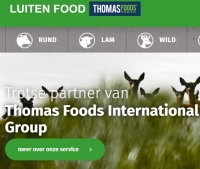 “Keep up the good work and search for more sustainability on your farms. We need to get more into sustainability and animal welfare.
“Keep up the good work and search for more sustainability on your farms. We need to get more into sustainability and animal welfare.
“I know New Zealand is far away, but the consumer is demanding from us to have a story that is really true, about water, energy, how you treat animals… It’s a very important USP [unique selling proposition], especially for retailers.”
Alexander Eyckeler, Alexander Eyckeler GmbH, (partner of Alliance Group for Ashley Brand venison).
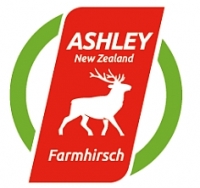 “Young consumers care. They want to know where the product comes from. They want not only to know that it comes from New Zealand, they want to know how old the animals are, how they have been treated, what is their diet.
“Young consumers care. They want to know where the product comes from. They want not only to know that it comes from New Zealand, they want to know how old the animals are, how they have been treated, what is their diet.
“They want answers to sustainability. They want to know that the complete animal is being consumed [that there’s no waste].”
Speaking on live stream to the Deer Industry Conference, agriculture minister Damien O’Connor had this to say:
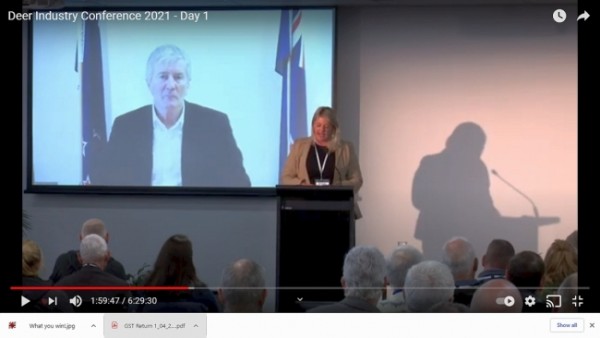
Winter grazing rules: “There have to be changes made [in the proposed National Policy Statement]. Some of the [rules] were clearly wrong. They were rolled out the door maybe a little too quickly, so we will make those changes, but the objectives remain in place. We want to see good animal welfare standards maintained and we don’t want to see the unnecessary loss of soil or water degradation.
“We’ve been working with the regional councils, MPI down on the ground, talking directly to farmers, identifying the risks and how we can mitigate them. We [want] practical proposals to come out of this, but we have to be mindful that images go out around the world and if we are wanting to sell high quality venison and deer products, milk or whatever, we have got to be able to show that we’ve got good animal welfare standards and that we are looking after the environment. If we can’t, we will be struggling to get the value that we need to be viable.”
RMA reforms: “The RMA hasn’t served us well. It has become quite a beast. It is being reformed to make sure that what we do with farm plans, the NPS and the RMA are all consistent. It will hopefully reduce the bureaucracy we have been facing.
“We are working on how that will happen through an integrated farm plan. That will be the one process we all go through to meet all the requirements we have, be it health and safety, biosecurity, animal welfare. All those things that are part and parcel of farming now. We need to streamline the process so we can show people who ask the question – it might be the processor, it might be the regional council, it might be the vet – that we are doing the right thing. And if not, to make the adjustments so we can improve it.”
Protecting and enhancing biodiversity: “[The proposed NPS on indigenous biodiversity] won’t take the control of these areas out of farmers’ hands. It will hopefully endorse the good work farmers are doing. The SNA requirements have been around for 30 years and have been implemented in variable ways across the country. [We now plan] to move ahead and standardise it.
“I hope – and there is still a lot of work to be done in this area – that the areas councils will designate [as SNAs] will be the areas that the farmers have chosen already. The issues of fencing and maybe some incentives; those things still have to be worked through. But I clearly believe that we should have the acknowledgement and the incentives… some will talk of a rates rebate for the area. Those are points for discussion as we go forward.”

